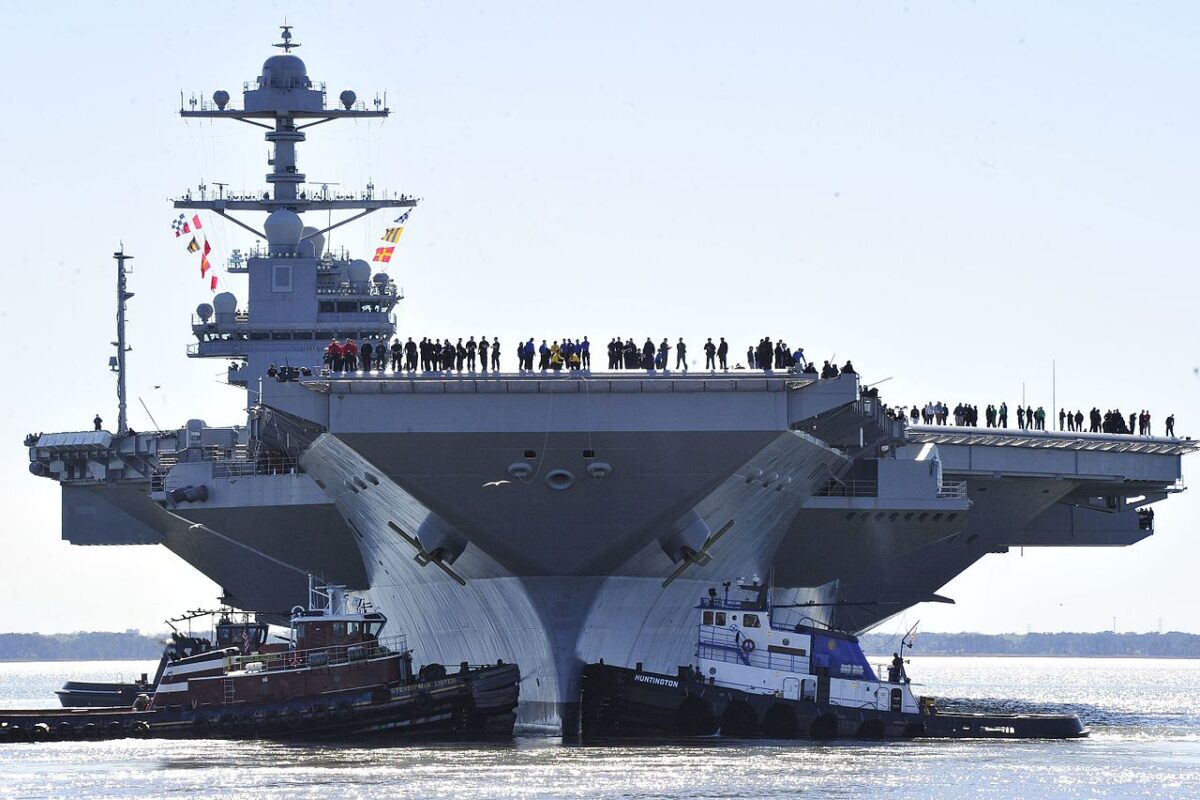The Chinese Communist Party wants the world to know that it can sink U.S. Navy aircraft carriers from range. But how far, with the DF-26B anti-ship missile, some experts think China could attack and kill an aircraft carrier or warship from 1,000 miles away – or more.
You may know that China has one carrier-killing missile, but what if I told you it has two?
The DF-21D is an anti-ship ballistic missile that 1945 has analyzed before. There is another – one with an even greater range than the 1,000-mile DF-21D.
The DF-26B, an anti-ship model that is a DF-26 variant, has a range up to 2,500 miles that could reach ships as far away as Guam.
Two years ago, China tested both missiles successfully in a launch at what may have been moving targets at a location between Hainan province and the Paracel Islands in the South China Sea. China warned its adversaries “not to meddle in China’s core interests,” after the tests.
What Is the DF-26B?
The DF-26B is road-mobile, and it is a two-stage solid-fueled model with a 4,000 pound payload.
It was first seen at a parade in 2015. The missile is 46 feet long, six feet in diameter, and weighs 22 tons. It is carried by truck that can go 40 miles per hour on roads.
The missile can be fitted with a nuclear warhead, and the six-man crew can switch the payload from conventional high-explosive to nuclear while they are deployed at a location.
The DF-26B is able to engage moving targets because of its reported “active terminal seeker.”
Sounding Warning Bells
Chinese missile expert Andrew Erickson has warned against China’s anti-ship ballistic missiles since 2007. Erickson believes the Chinese have at least 200 or more DF-26 launchers and many of these are the ship killing DF-26B model. They are quickly developing and deploying these, Erickson said in an interview with Harry Kazianis in a report recounted in this publication.
Becoming More and More Accurate
Erickson thinks that the DF-26B has the adequate targeting and reconnaissance structure to be effective against enemy shipping. This makes the Chinese able to overpower their neighbors and threaten the U.S. Navy. The tests of the DF-26B and DF-21D have been valuable, he said.
“Beijing seeks to demonstrate a maturing capability and enhance deterrence. It seeks to overawe audiences limited in access to technical details and limited in understanding of basic technical principles—and thereby to generate deference that it has not earned operationally. But however sophisticated and successful, these tests are but one element in a far greater equation,” Erickson said.
How Does the U.S. Navy Defend Against It?
As I have recounted before, the U.S. Navy will have to depend on the AEGIS sea-based ballistic missile defense system on board its escort ships that steam with carrier battle groups. Standard Missile-6 and Standard Missile-3 interceptors will have to protect the carrier. SM-6 interceptors are on board at least 60 American ships. The SM-6 Block 1A has been tested since 2017 against terminal phases of incoming enemy missiles, and now the SM-6 Block 1B could be an improved version that would better defend against China’s ship-killing missiles.

NEWPORT NEWS, Va. (April 8, 2017) – Pre-Commissioning Unit Gerald R. Ford (CVN 78) Sailors man the rails as the ship departs Huntington Ingalls Industries Newport News Shipbuilding for builder’s sea trials off the coast. The first- of-class ship—the first new U.S. aircraft carrier design in 40 years—will spend several days conducting builder’s sea trials, a comprehensive test of many of the ship’s key systems and technologies. (U.S. Navy photo by Chief Mass Communication Specialist Christopher Delano).
Could the DF-26B Be a Danger to Guam?
What is additionally troubling is the DF-26B’s (or standard DF-26) ability to hit Guam. To be sure, Guam is defended by THAAD and Patriot air defense systems, but Guam is the decisive point for U.S. forces in East Asia. It is a critical strategic base that quarters nuclear bombers, naval re-supply facilities, and American personnel. A successful missile launch against Guam would be devastating.
Losing an aircraft carrier would be unthinkable as well. Congress has been warned repeatedly about China’s ship-killing missiles in expert testimony and China’s military power reports prepared for lawmakers. More people will have to bang the drum to get the navy and defense contractors to improve the AEGIS ballistic missile defense system. This is the only way U.S. aircraft carriers can protect freedom of navigation shipping lanes for the navy and other types of commercial shipping. China looks to have the upper hand with its carrier-killing missiles at this time.
Expert Biography: Now serving as 1945’s Defense and National Security Editor, Brent M. Eastwood, PhD, is the author of Humans, Machines, and Data: Future Trends in Warfare. He is an Emerging Threats expert and former U.S. Army Infantry officer.

